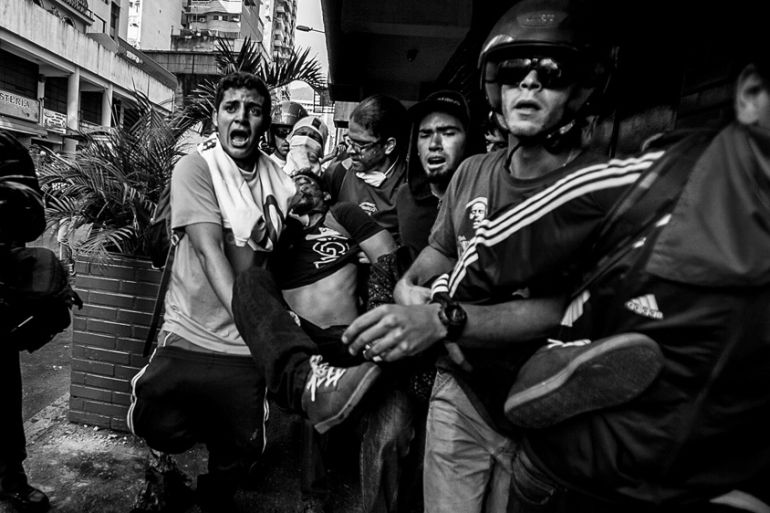Magazine: The end of youth
Photojournalist Alejandro Cegarra remembers the day he photographed the death of Venezuelan student Bassil Da Costa.

It was February 12, 2014, or Youth Day in Venezuela. In the capital, Caracas, students and members of the opposition were gathering to march towards the public prosecutor’s office. Days before, there had been protests in Táchira, a state bordering Colombia that has long been a headache for the Venezuelan government. But, if truth be told, I expected the protests in Caracas to be similar to those of previous years: uneventful and even a bit dull.
Which was lucky, I thought, as despite having worked as a photojournalist for just a couple of months and being, I imagined, quite obviously inexperienced, circumstances dictated that I’d be the only one covering the event for the Associated Press. With one photographer away and the other on maternity leave, their choice was, well, me or me.
Keep reading
list of 4 itemsA year of survival in the Turkey-Syria earthquake zoneThis article will be opened in a new browser window
‘If I die, I die’: The allure of Pakistan’s death-trap route to Europe
Lojay, the preacher’s son minting romantic anthems from stripper therapy
So I arrived, without any protective gear, and not a single thought that harm might come my way. I’d been asked several times if I shouldn’t be taking a protective vest with me, to which I’d nonchalantly replied: “No, what for?” But, once there, Jose Silva, a Reuters’ photographer and somebody I respect greatly, phrased it a little differently. In the Mexican accent he has retained despite spending more than 12 years in Venezuela, he told me: “Hey, call for a little vest, yes? One never knows.”
So it was that when the march started some 45 minutes later, to the almost war-like cry of “Let’s go, let’s go,” from those at its helm, I was wearing not only a vest but a helmet. Slogans were shouted as the protesters dodged police barricades to reach the public prosecutor’s office. It had been a long time since the opposition had been able to mobilise so many people outside of an election year, I thought.
There were speeches made and slogans shouted when they’d reached their intended destination. But when the dense crowd didn’t begin to disperse, the police arrived. Their presence added fuel to the fire of the protesters’ fury. Suddenly, youngsters who’d arrived with their faces uncovered, began to use their shirts to conceal them. More slogans were shouted, but this time insults and stones were hurled along with them. Then everything turned hazy, and to this day, I still have difficulty recalling just what happened next.
What I do remember is that a police barricade dispersed and a group of officers from SEBIN, the Bolivarian National Intelligence Service, Venezuela’s premier intelligence agency, arrived in their urban camouflage uniforms. When the protesters attempted to steal and burn one of their bikes, the officers opened fire. Kids wielding sticks and stones were suddenly confronted with live ammunition. It was the third time I’d been caught in the crossfire (it happened once when I was a child and again during a police operation) and the sound of bullets whistling past your head is something you hope never to hear again.
I spotted a more experienced photographer – one I’d always thought resembled a soldier, if only his camera had been replaced with a gun – and decided to shadow him. It allowed me a few moments of calm, but no sooner had it arrived than it was shattered by screams; the sort of harrowing screams that tell you something is seriously wrong. “He’s been hit. He’s been hit. Carry him. Carry him.” I heard them shout.
I had no idea what had happened. I looked, torn between wanting to see and knowing I’d probably wish I hadn’t. I sensed I was in a situation way above my pay grade, and it felt like a wave crashing down upon my head, allowing me just a few seconds in which to gasp for air.
There was a group of youngsters, running, carrying a body, terror etched onto their faces. I ran in front of them. I fell. I heard more gunshots. And for a moment, for a brief moment, I thought of not getting up. I instinctively let go of my camera and covered my head with my hands, like a child hiding beneath a blanket, afraid of the monster lurking in the closet. I was afraid. And I wanted it all to just go away.
![The body of Bassil Da Costa is lifted into a police vehicle [Alejandro Cegarra]](/wp-content/uploads/2015/05/401c1afc023d4602b7e498848a1daf60_18.jpeg)
And then, like some kind of guardian angel, a stranger picked me up, grabbed my camera and threw it at my chest with an authoritative yell to: “Get up, photographer.”
I ran as fast as I could to where they carried the lifeless body of Bassil Da Costa, a university student who had been killed by a SEBIN bullet to the head in broad daylight. I took this picture of him then, as patrol cars burned and men with long guns arrested protesters and photographers alike.
I ran as quickly as I could to broadcast the image. Nobody knew what was happening in the centre of Caracas that day, but I carried part of the truth in my memory stick and knew I had to get it out in order to break the wall of censorship that was already being built.
The end of youth appeared in the latest issue of the Al Jazeera Magazine, What this picture means to me. For more compelling human stories, download it here for iPads and iPhones and here for Android devices.